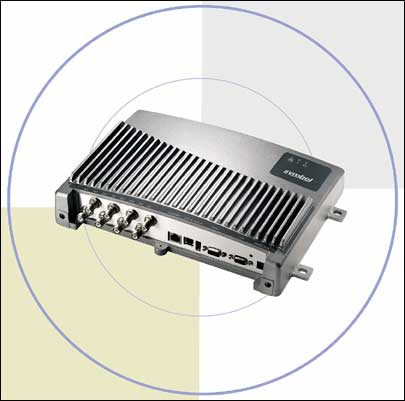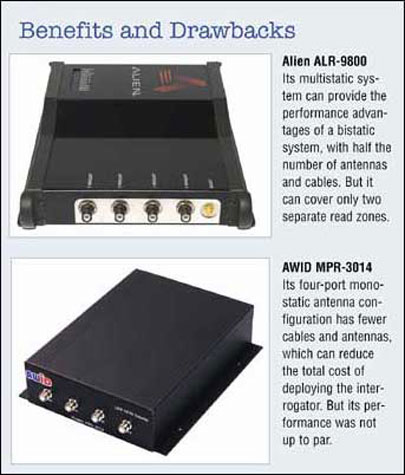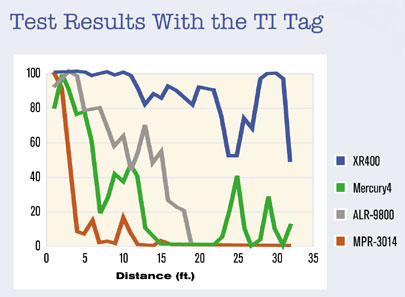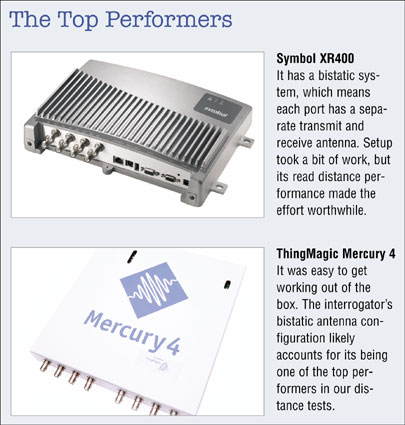Jun 01, 2006Many companies are anticipating the improved performance promised with EPCglobal's Generation 2 interrogators and tags. Gen 2 incorporates numerous enhancements over Gen 1, including faster data-transfer rates, greater security of tag data and special features such as "dense-reader mode," which can greatly increase read rates when more than a handful of interrogators share the same space. In addition, more efficient use of the allowed ultrahigh-frequency spectrum should boost performance when reading tags on goods traveling on high-speed conveyors or through dock doors.
The RFID Alliance Lab, a not-for-profit research facility, tested the Gen 2 interrogators that have earned EPCglobal certification by an accredited lab. Certification means an interrogator has undergone a series of tests to ensure that it conforms to Gen 2 specifications and implements all the mandatory features. There are many Gen 2 interrogators on the market that have not been certified. These may be compatible with Gen 2 standards, but there is no guarantee until they have been certified.

When we conducted our tests in the first quarter of 2006, there were five certified Gen 2 interrogators: Alien ALR-9800, AWID MPR-3014, Impinj Speedway, Symbol XR400 and ThingMagic Mercury4, running version 2.3.14 of the interrogator's operating system (the firmware that runs the device). The Impinj Speedway was not being offered for sale, so we did not test it (the interrogator should be available by the time you read this article). Also, Intermec and MaxID Group offer EPC-certified interrogator modules that can be incorporated into printers and other devices, and SAMSys Technologies offers a certified interrogator that operates under European Telecommunications Standards Institute (ETSI) regulatory restrictions, but we chose not to test modules or ETSI interrogators for now. (SAMSys went into receivership and its assets were purchased recently by Sirit, an RFID systems provider.)
In this report, we focus on the design of each interrogator and how it affects performance. We also explain several of the optional features of the Gen 2 protocol and examine if and how they are implemented in the interrogators (see sidebar on page 32).
Upgrading to Gen 2
If you've purchased and installed Gen 1 interrogators, your upgrade path will depend on the kind of interrogator you purchased. Those who have the Gen 1 ThingMagic Mercury4 interrogator will have the easiest route. It can be upgraded to Gen 2 by installing new firmware (the firmware change is the only difference between the Gen 1 and Gen 2 versions). The process of upgrading the firmware involves launching a Web browser on a PC connected to the same network to which the interrogator is connected, typing in the proper URL to access the Web server running on the interrogator, and clicking on a few obvious menus and buttons. It takes about 5 minutes; bundled manuals provide the details.
The Alien ALR-9800, AWID MPR-3014 and Symbol XR400 are completely new products. Companies will need to remove their old interrogators and install the new hardware. Many vendors offer upgrades for their Gen 1 interrogators, such as the Alien ALR-9780, AWID MPR-2010 line and Symbol AR400, but none are on the list of certified Gen 2 interrogators, so it's not clear what level of compliance they have.
The Alien ALR-9800, Symbol XR400 and ThingMagic Mercury4 all come with a DC power supply that converts AC to DC power. The AWID MPR-3014 uses Power-over-Ethernet (PoE), which means that the interrogator gets power from the Ethernet cable. The Ethernet cable attaches to a PoE switch (which routes information through your intranet; PoE switches are relatively rare) or an adapter (one comes with the unit) that plugs into an AC outlet and converts normal Ethernet to PoE. If you have a PoE infrastructure and don't have AC power at the places you want to put the interrogators, the AWID MPR-3014 can reduce deployment costs by eliminating the need to run AC power lines.
The antenna configurations for the AWID MPR-3014, Symbol XR400 and ThingMagic Mercury4 are similar to those found in Gen 1 interrogators. The Symbol XR400 and ThingMagic Mercury4 each have four ports and use a bistatic antenna configuration. That means each port has separate transmit and receive antennas (both are usually contained in a single, large box) and two cables. They can connect up to eight antennas—four transmit and four receive—through eight different cables. The bistatic antenna configuration can give improved performance. The AWID MPR-3014 uses a four-port monostatic antenna configuration, which means each port connects to a single antenna that transmits and receives signals. It has fewer cables and antennas, which can reduce the total cost of deploying the interrogator.
The Alien ALR-9800 takes a multistatic approach. (The Gen 1 Alien ALR-9780 used a monostatic antenna configuration.) A multistatic system is similar to a monostatic one in that a single antenna is used to transmit and receive. But in a multistatic system, the antenna does not do both at the same time. The Alien ALR-9800 is also a four-port device, and connects to four antennas through four different cables. But more like a bistatic configuration, antennas are always used in pairs: One is used to transmit, while the other is used to receive. If port 1 transmits the RF signal, port 2 receives the signal from the tag, and when port 2 transmits, port 1 receives. Ports 3 and 4 operate as a second send-receive pair.
A multistatic system offers a number of potential benefits, such as the ability to provide the performance advantages of a bistatic system, while using half the number of antennas and cables. The downside is that it can cover only two separate read zones, because antennas 1 and 2 must cover the same area. If a tag is not within the radiation pattern of, or visible to, both antenna 1 and antenna 2, the interrogator will not detect the tag. In contrast, a four-port monostatic or bistatic interrogator can cover four separate read zones. If you want to use all four ports of the Alien ALR-9800 to cover a single portal, the multistatic system may work well. But if you want to cover four different, non-overlapping areas, you'll need a bistatic or monostatic interrogator. Also, if you are going to upgrade a dock-door implementation from a Gen 1 monostatic implementation to a Gen 2 monostatic interrogator, you may need to reconfigure your antenna positioning for optimal performance.
The simplest interrogators to use have a Web server running on the interrogator: Set up the network configuration for the interrogator (which will take an IT professional about five minutes), then launch a Web browser on a networked PC and type in the proper URL to access the interrogator and start reading tags. A good Web application lets you extensively configure the software portion of the interrogator, test the interrogator in different modes and upgrade the interrogator with periodic software and firmware updates. Another way to test an interrogator is to install a demonstration-like application, which often comes bundled with the interrogator on a CD.
The Alien ALR-9800 comes with both a Web server running on the interrogator and a demonstration application that is simple to install on a PC. Both are fairly complete and easy to use. The AWID MPR-3014 comes with a demonstration application that must be installed on a PC to access some of the interrogator's basic features. Installation is straightforward, but the application, while easy to use, is minimal.
Also, we found a bug in the application: The read rate for the "single tag meter" feature displays random results, so we developed our own software application for testing. The Symbol XR400 comes with a Web server that is useful for configuring the interrogator, but to test the device, you need to install an included demonstration application on a PC; it was difficult to install and configure properly. The ThingMagic Mercury4 comes with a Web server that allows you to easily set some of the basic options and test the interrogator with a demonstration application that runs on the interrogator.
All of the interrogators come with documentation describing how to write software applications for the device. But you probably won't need it, because you'll likely use middleware to interface with the interrogator.
Read Distance Performance
One of the first questions most people ask about Gen 2 is, "How far away can interrogators read tags?" The answer depends on numerous factors, including the orientation of the interrogator antennas and the tags, RF interference and what material the RFID tags are attached to. To make meaningful comparisons, we tested each interrogator with the same tags and in the same environment.
For our read distance performance tests, we used five different Gen 2 tags, each with an EPCglobal-certified integrated circuit (EPCglobal uses a third-party testing company, Met Laboratories, to test whether an RFID microchip conforms to the Gen 2 air-interface protocol standard). We set the interrogator to the factory default settings and maximum allowable output power, and placed the tag directly in line with the antenna at varying distances. The tests were performed in a large, open environment with a concrete floor. At each distance, we performed read attempts for 60 seconds—long enough to get a statistically reliable result—and recorded the number of reads.
Since different interrogators read at different speeds, we normalized the results. For example, if the largest number of reads per 60 seconds for an interrogator was 500, that number is graphed at 100 percent; a distance in which that interrogator read the tag 300 times in 60 seconds is graphed at 60 percent.
The read performance of the interrogators varied depending on the tag with which they were tested. In general, the Symbol XR400 and ThingMagic Mercury4 were the best performers, and the Alien ALR-9800 outperformed the AWID MPR-3014. For example, with the Texas Instruments Gen 2 tag (which has an Impinj integrated circuit), the Symbol XR400 and ThingMagic Mercury4 were able to read tags much farther away than the Alien ALR-9800, with the clear edge going to the Symbol XR400. (The ThingMagic Mercury4 performance was closer to that of the Symbol XR400 with other Gen 2 tags.) Since both the Symbol XR400 and Mercury4 use bistatic antennas, this result shows a clear advantage for these systems.
The AWID MPR-3014 struggled to read the TI tag more than a dozen feet away, and it would give "ghost reads," or indicate there were tags in the read field that were not there. Ghost reads are a known problem with EPC Class 0 tags, and the Gen 2 protocol was designed to eliminate them. Also, the AWID MPR-3014 was not able to read a UPM Raflatac tag (which has a Philips IC). AWID says that it expects to begin shipping by the end of May an improved version of the MPR-3014, with both better and more consistent performance. (AWID is also investigating claims that some of its interrogators are not certified by the Federal Communications Commission.)
Notice that the plots on the chart on page 31 are anything but smooth. Sometimes moving the tag farther away can improve the tag performance. What's happening is something called multipath—that is, there are two paths for RF to propagate between the interrogator antenna and tag: a direct line of sight and a path that bounces off the floor. Depending on the lengths of the two paths, the RF energy from the two paths can combine and boost tag performance or one path's energy may cancel out the other and cause a region of poor or no performance, called a null zone.
Conclusions
Unless you own ThingMagic Mercury4 interrogators, if you want certified Gen 2 interrogators, you will need to buy new hardware. We found the Alien ALR-9800 and ThingMagic Mercury4 were the easiest to get working out of the box, but the AWID MPR-3014 was not overly difficult. The Symbol XR400 took more work than it should have, but its read distance performance made the effort worthwhile.
When it comes to read distances, the two interrogators that use bistatic antennas—the Symbol XR400 and ThingMagic Mercury4—could read tags farther away than the multistatic Alien ALR-9800 and the monostatic AWID MPR-3014. Keep in mind that the results we observed can vary, depending on the tag the interrogator is reading and the environment.
It's also important to remember that not all applications require the ability to read tags far away, and sometimes the ability to do so can be counterproductive. For example, a portal interrogator for a conveyor might pick up cases on a neighboring conveyor, or a dock door's interrogator may read pallets coming through a neighboring door. Other applications, such as reading as many cases on a pallet as possible, will benefit from the extra read distance. But there may not be a significant difference between, say, 50 percent and 70 percent read rates, since Gen 2 interrogators can perform hundreds of read attempts per second, and the interrogator only needs to successfully read the tag once.
While we haven't seen Gen 2 interrogators perform "amazingly" better than Gen 1, Gen 2 certainly is not a step backward. What we are most likely seeing are the results of early attempts at implementing the technology in interrogators that will be refined and improved over time. For example, over the past two years we have observed a steady improvement in Gen 1 performance using the same tags and interrogators. Last year we observed the Mercury4 reading Class 0 tags about 8 times per second, but with the latest software, the same Mercury4 is reading the same Class 0 tags nearly 100 times per second. There's every reason to believe that Gen 2 is going to enjoy the same kind of improvements, as vendors learn how to implement Gen 2 more efficiently.
Gen 2 interrogators, while fully functional, still have a way to go before they reach their full potential. Many of the optional features that make the Gen 2 standard attractive and applicable to a wide variety of environments are not currently available to end users, including these four key features.
Variable data rates.
The Gen 2 protocol allows for a variety of data rates in both tag-to-interrogator and interrogator-to-tag communication. Higher data rates mean faster reads, but more sensitivity to RF noise. Slower data rates will yield slower reads, but more robustness against noise. But you're stuck with whatever data rates the manufacturer gives you. There's no way to tune these interrogators for noisy or quiet environments.
Choice of modulation.
Tags communicate with interrogators by encoding zeros and ones onto variations of the interrogator's reflected signal. The particular variation that does the encoding is called the modulation. The Gen 2 protocol allows interrogators to instruct tags to use one of several modulations, including FM0, Miller-2, Miller-4 or Miller-8. FM0 is used in the IS0 18000-6a and -6b standards, but the Miller encoding offers new capabilities to Gen 2 that will likely give better performance in noisy environments. None of the readers give you the ability to explicitly choose which modulation to use.
Dense-reader mode.
All the interrogators support dense-reader mode (DRM), which allows many interrogators to share the same physical space more efficiently without polluting the RF spectrum. The Alien ALR-9800 and ThingMagic Mercury4 give a clear and easy way to choose whether to operate in DRM, while the AWID MPR-3014 and Symbol XR400 do not. None implement the optional Multiple-Interrogator Mode, a useful intermediate mode between a single and "dense" interrogator environment.
Flexibility in how to set and use the Q algorithm.
The Q algorithm is used to tune performance based on the number of tags that are being inventoried. It's likely that each interrogator dynamically adjusts the Q parameter based on the number of tags it sees or doesn't see when it's trying to read tags. But it's often up to you to provide the "optimal" starting Q value for your application-a number between zero and 15. The Alien ALR-9800 and ThingMagic Mercury4 allow you to set the initial value, while the AWID MPR-3014 and Symbol XR400 do not.
About the RFID Alliance Lab
Daniel Deavours, Ph.D., is the research director of the RFID Alliance Lab, which is dedicated to unbiased testing of RFID products. The lab performs testing at the University of Kansas and is supported by Rush Tracking Systems and rfid journal. To learn more about the lab, purchase reports or find out how the lab can help you, go to www.rfidjournal.com/labreports.



